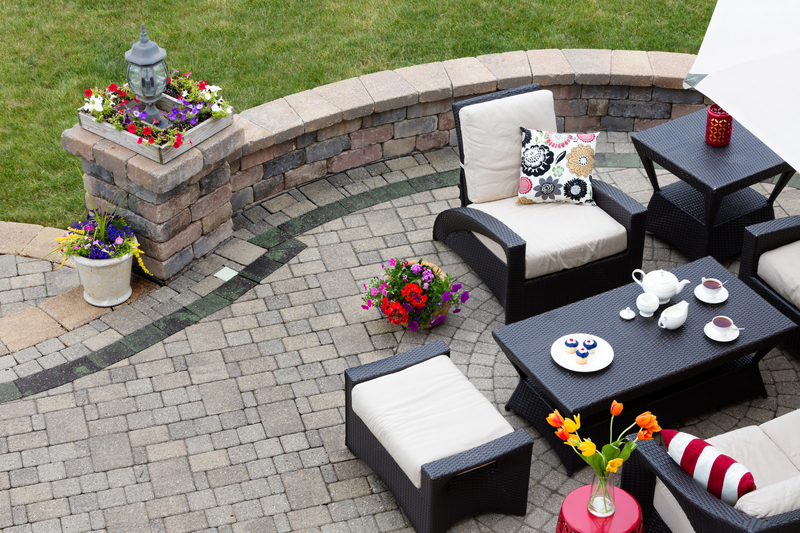Creative Techniques for Trimming Hedges
Posted on 27/05/2025
Creative Techniques for Trimming Hedges: Transform Your Garden
Hedges are more than just living fences. When cared for creatively, they can be a dramatic focal point in garden design, offering privacy, structure, and year-round interest. With the right hedge trimming techniques, you can elevate ordinary shrubs into vibrant, eye-catching displays. In this comprehensive guide, we'll unveil innovative and artistic methods for trimming hedges that will inspire both novice and seasoned gardeners alike.
Why Master Creative Hedge Trimming?
Traditional hedge maintenance focuses on keeping lines tidy and plants healthy. However, embracing creative hedge shaping turns landscaping into an art form. Not only does this boost curb appeal and property value, but it also provides personal satisfaction and a unique talking point for your space.
- Enhance landscape aesthetics
- Reflect personal style in your garden
- Encourage healthy hedge growth
- Create unique garden features

Essential Tools for Artistic Hedge Pruning
Before exploring creative hedge trimming techniques, make sure you have these must-have tools for hedge shaping:
- Hedge Shears: For basic shaping and general maintenance.
- Pruning Saws: For thicker branches that hand shears can't handle.
- Electric or Battery Hedge Trimmers: Great for large and uniform hedges.
- Topiary Frames: Useful for intricate designs and maintaining precise forms.
- String, Stakes, and Measuring Tape: Handy for marking out precise patterns and even lines.
Sharp, clean tools are essential for healthy plants and crisp results.
Popular Creative Hedge Trimming Ideas
If you're ready to go beyond the basic box or ball, here are some innovative hedge design ideas to consider:
1. Geometric Patterns and Clean Lines
Geometric designs--such as cubes, spheres, pyramids, and spirals--are classics of creative hedge trimming. These striking shapes bring sophistication and visual order to gardens of any style.
- Square or Rectangular Hedges: Perfect for a formal, stately look along pathways or property lines.
- Round or Ball-shaped Hedges: Add softness and counterbalance hard landscaping features.
- Pyramids and Cones: These work well as focal points or to add height variety.
- Spiral Hedges: Ideal for topiary and more advanced gardeners.
Use stakes and string as guides to achieve perfect lines and symmetry.
2. Topiary Art: Living Sculptures
Topiary is the ancient art of shaping living plants into whimsical forms. It adds an element of surprise and delight to any garden. Common topiary shapes include:
- Animals (peacock, elephants, rabbits)
- Globes and tiered balls
- Spirals and geometrical columns
- Letters and intricate patterns
Tip: Use a metal or wire topiary frame as a guide, especially when starting out with complex shapes. Train young hedges early for best results.
3. Naturalistic and Flowing Forms
If formal shapes aren't your style, consider a more organic approach to hedge trimming. Mimic the natural growth habits of the plant, creating wavy lines, staggered heights, or curved edges that blend seamlessly with the surrounding landscape.
- Wavy Borders: Draw the eye gently along a path.
- Layered or Tapered Hedges: Provide depth and movement.
- Cloud Pruning: Create a billowing, soft effect--perfect for Japanese-inspired gardens.
Cloud-pruned hedges (Niwaki) are especially striking, with rounded, cloud-like clumps carefully sculpted for serenity and flow.
4. Hedge Archways and Tunnels
Transform passageways with a hedge arch or tunnel. These enchanting features invite exploration and help define garden "rooms".
- Plant two parallel hedges and gradually trim the tops to curve inward.
- Use a metal or bamboo frame for precise arch shapes.
- Incorporate flowers for seasonal color bursts.
Pro Tip: Certain species, like hornbeam or yew, are ideal for archways due to their flexible branches and dense foliage.
5. Living Walls and Patterns
Create a vertical garden by shaping hedges into green walls with integrated patterns. These are perfect for privacy screens or to break up large expanses.
- Sculpt chevrons, zig-zags, or diamond patterns using hand shears.
- Alternate leafy and flowering species for textural and color contrast.
- Install trellis and weave hedge branches for added support and design complexity.
This artistic approach to hedge trimming transforms even simple boundaries into statement pieces.
Step-by-Step Guide: Techniques for Advanced Hedge Shaping
-
Plan Your Design
Mark out your desired shape using string, stakes, or chalk. -
Start with Clean, Sharp Tools
Disinfect and sharpen blades to ensure smooth, disease-free cuts. -
Cut Gradually
Remove small amounts at a time--hedge growth is slow! -
Stand Back and Inspect
Regularly step away to assess symmetry and design progress. -
Maintain and Adjust Yearly
Revisit shapes at least once per season for sharp, well-defined lines and healthy growth.
Seasonal Tips for Creative Hedge Maintenance
For successful creative hedge cutting, attention to timing is crucial for optimal plant health:
- Spring (Late): Best time for major shaping, just after new growth emerges but before birds start nesting.
- Summer: Light trimming can maintain shape, but avoid deep cuts during extreme heat.
- Autumn: Last chance for shaping before frost; avoid trimming evergreens too late to prevent winter burn.
- Winter: Some deciduous hedges can be cut back when dormant, but avoid shaping evergreens in freezing weather.
Always check for nesting birds or wildlife before trimming in spring and summer.
Best Hedge Species for Creative Shaping
Selecting the right plant is key to achievable and long-lasting designs. Here are the most versatile shrubs for creative hedge trimming:
- Buxus sempervirens (Boxwood): Classic for topiary and geometric shapes; responds extremely well to close trimming.
- Taxus baccata (Yew): Dense, slow-growing, ideal for living sculptures and neat lines.
- Ligustrum (Privet): Grows quickly and thickly, perfect for archways and formal shapes.
- Carpinus betulus (Hornbeam): Flexible branches, great for arches and flowing forms.
- Lonicera nitida (Shrubby Honeysuckle): Fast-growing, small-leafed, and easy to train in fine detail.
- Berberis, Euonymus, and Photinia: These add color and variety to shaped hedges and living walls.
Experiment with combinations to suit your garden due to each plant's unique foliage, color, and growth habits.
Maintaining Health While Shaping Hedges
Even the most artistic hedge trimming must prioritize the plant's well-being. Follow these hedge care best practices:
- Don't cut into old wood excessively--not all species can regenerate from hard pruning.
- Shape so the base is slightly wider than the top; this ensures sunlight reaches all parts and prevents bare lower branches.
- Thin out the interior occasionally to encourage airflow and reduce disease risk.
- Remove dead or diseased wood promptly.
- Water, feed, and mulch regularly to support lush growth and recovery after creative cutting.
Healthy hedges are always the most beautiful and rewarding to shape.
Eco-Friendly and Sustainable Hedge Trimming Methods
Modern creative gardeners are conscious of their environmental impact. Here's how to make your artistic hedge shaping greener:
- Use manual tools whenever possible to reduce noise and emissions.
- Compost clippings or create wildlife piles for beneficial insects and small animals.
- Avoid pesticides and harsh chemicals; healthy, diverse gardens resist pests naturally.
- Choose native species to support local pollinators and wildlife.
- Trim outside peak nesting times to safeguard bird populations.
Common Mistakes to Avoid When Shaping Hedges
Hedge shaping is a learning process. Sidestep these frequent errors for the best results:
- Overpruning: Removing too much foliage shocks the plant, causing browning and poor recovery.
- Ignoring Plant Type: Some species don't respond well to hard shaping--research before you trim.
- Incorrect Timing: Cutting at the wrong season risks disease and poor regrowth.
- Poor Tool Maintenance: Dull blades tear instead of cut, damaging stems and inviting disease.
- Neglecting Safety: Always wear gloves and eye protection, especially when working with powered tools.

Combining Hedge Designs for Extra Impact
For truly stunning landscapes, layer creative trimming techniques together:
- Pair geometric shapes with flowing edges for contrast and interest.
- Combine living archways with patterned walls for a garden maze effect.
- Intermingle colored and evergreen hedges for all-season vibrancy.
- Use topiary as punctuation at the end of formal hedges.
The only limit is your imagination and the natural growth of your plants.
Conclusion: Unleash Your Creativity with Artistic Hedge Trimming
Transforming your hedges from functional greenery into living art is both satisfying and impactful. By adopting creative techniques for trimming hedges--from geometric forms and flowing patterns to whimsical topiary and layered designs--you can express your personality, enhance your space, and support a healthy garden ecosystem. With ongoing care and a spirit of adventure, your hedge will become a masterpiece that evolves year after year.
Ready to create, sculpt, and shape? Grab your shears, choose your design, and let your hedges become the stars of your outdoor retreat!
Related Resources:
- Best Plants for Creative Hedge Shaping
- Hedge Trimming Safety Tips
- How to Maintain Topiary in All Seasons
- Eco-Friendly Garden Design Ideas



